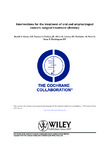Interventions for the treatment of oral and oropharyngeal cancers: surgical treatment
| dc.contributor.author | Norman, Alyson | |
| dc.contributor.author | Glenny, A-M | |
| dc.contributor.author | Furness, S | |
| dc.contributor.author | Clarkson, JE | |
| dc.contributor.author | Oliver, R | |
| dc.contributor.author | Conway, DI | |
| dc.contributor.author | Macluskey, M | |
| dc.contributor.author | Pavitt, S | |
| dc.contributor.author | Sloan, P | |
| dc.contributor.author | Worthington, HV | |
| dc.date.accessioned | 2014-10-27T14:33:18Z | |
| dc.date.available | 2014-10-27T14:33:18Z | |
| dc.date.issued | 2011 | |
| dc.identifier.issn | 1469-493X | |
| dc.identifier.issn | 1465-1858 | |
| dc.identifier.other | ARTN CD006205 | |
| dc.identifier.uri | http://hdl.handle.net/10026.1/3145 | |
| dc.description.abstract |
BACKGROUND: Surgery is an important part of the management of oral cavity cancer with regard to both the removal of the primary tumour and removal of lymph nodes in the neck. Surgery is less frequently used in oropharyngeal cancer. Surgery alone may be treatment for early stage disease or surgery may be used in combination with radiotherapy, chemotherapy and immunotherapy/biotherapy. There is variation in the recommended timing and extent of surgery in the overall treatment regimens of people with these cancers. OBJECTIVES: To determine which surgical treatment modalities for oral cavity and oropharyngeal cancers result in increased overall survival, disease free survival, progression free survival and reduced recurrence. SEARCH STRATEGY: The following electronic databases were searched: the Cochrane Oral Health Group Trials Register (to 17 February 2011), the Cochrane Central Register of Controlled Trials (CENTRAL) (The Cochrane Library 2011, Issue 1), MEDLINE via OVID (1950 to 17 February 2011) and EMBASE via OVID (1980 to 17 February 2011). There were no restrictions regarding language or date of publication. SELECTION CRITERIA: Randomised controlled trials where more than 50% of participants had primary tumours of the oral cavity or oropharynx, and which compared two or more surgical treatment modalities or surgery versus other treatment modalities. DATA COLLECTION AND ANALYSIS: Data extraction and assessment of risk of bias was undertaken independently by two or more review authors. Study authors were contacted for additional information as required. Adverse events data were collected from published trials. MAIN RESULTS: Seven trials (n = 669; 667 with cancers of the oral cavity) satisfied the inclusion criteria, but none were assessed as low risk of bias. Trials were grouped into three main comparisons. Four trials compared elective neck dissection (ND) with therapeutic neck dissection in patients with oral cavity cancer and clinically negative neck nodes, but differences in type of surgery and duration of follow-up made meta-analysis inappropriate. Three of these trials reported overall and disease free survival. One trial showed a benefit for elective supraomohyoid neck dissection compared to therapeutic ND in overall and disease free survival. Two trials found no difference between elective radical ND and therapeutic ND for the outcomes of overall survival and disease free survival. All four trials found reduced locoregional recurrence following elective ND.A further two trials compared elective radical ND with elective selective ND and found no difference in overall survival, disease free survival or recurrence. The final trial compared surgery plus radiotherapy to radiotherapy alone but data were unreliable because the trial stopped early and there were multiple protocol violations.None of the trials reported quality of life as an outcome. Two trials, evaluating different comparisons reported adverse effects of treatment. AUTHORS' CONCLUSIONS: Seven included trials evaluated neck dissection surgery in patients with oral cavity cancers. The review found weak evidence that elective neck dissection of clinically negative neck nodes at the time of removal of the primary tumour results in reduced locoregional recurrence, but there is insufficient evidence to conclude that elective neck dissection increases overall survival or disease free survival compared to therapeutic neck dissection. There is very weak evidence from one trial that elective supraomohyoid neck dissection may be associated with increased overall and disease free survival. There is no evidence that radical neck dissection increases overall survival compared to conservative neck dissection surgery. Reporting of adverse events in all trials was poor and it was not possible to compare the quality of life of patients undergoing different surgeries. | |
| dc.format.extent | CD006205- | |
| dc.format.medium | Electronic | |
| dc.language | en | |
| dc.language.iso | eng | |
| dc.publisher | Wiley | |
| dc.subject | Combined Modality Therapy [methods] | |
| dc.subject | Mouth Neoplasms [*surgery] | |
| dc.subject | Oropharyngeal Neoplasms [*surgery] | |
| dc.subject | Randomized Controlled Trials as Topic | |
| dc.subject | Humans | |
| dc.title | Interventions for the treatment of oral and oropharyngeal cancers: surgical treatment | |
| dc.type | journal-article | |
| dc.type | Journal Article | |
| dc.type | Meta-Analysis | |
| dc.type | Review | |
| dc.type | Systematic Review | |
| plymouth.author-url | https://www.webofscience.com/api/gateway?GWVersion=2&SrcApp=PARTNER_APP&SrcAuth=LinksAMR&KeyUT=WOS:000294642700030&DestLinkType=FullRecord&DestApp=ALL_WOS&UsrCustomerID=11bb513d99f797142bcfeffcc58ea008 | |
| plymouth.issue | 9 | |
| plymouth.publication-status | Published online | |
| plymouth.journal | Cochrane Database of Systematic Reviews | |
| dc.identifier.doi | 10.1002/14651858.cd006205.pub3 | |
| plymouth.organisational-group | /Plymouth | |
| plymouth.organisational-group | /Plymouth/Faculty of Health | |
| plymouth.organisational-group | /Plymouth/Faculty of Health/School of Psychology | |
| plymouth.organisational-group | /Plymouth/REF 2021 Researchers by UoA | |
| plymouth.organisational-group | /Plymouth/REF 2021 Researchers by UoA/UoA04 Psychology, Psychiatry and Neuroscience | |
| plymouth.organisational-group | /Plymouth/Research Groups | |
| plymouth.organisational-group | /Plymouth/Research Groups/Centre for Brain, Cognition and Behaviour (CBCB) | |
| plymouth.organisational-group | /Plymouth/Research Groups/Centre for Brain, Cognition and Behaviour (CBCB)/Behaviour | |
| plymouth.organisational-group | /Plymouth/Users by role | |
| plymouth.organisational-group | /Plymouth/Users by role/Academics | |
| dc.publisher.place | England | |
| dc.identifier.eissn | 1465-1858 | |
| dc.rights.embargoperiod | Not known | |
| rioxxterms.versionofrecord | 10.1002/14651858.cd006205.pub3 | |
| rioxxterms.licenseref.uri | http://www.rioxx.net/licenses/all-rights-reserved | |
| rioxxterms.type | Journal Article/Review |


